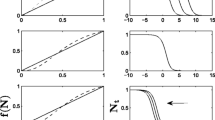Abstract
We explore the dynamics of invasive weeds by partial differential equation (PDE) modelling and applying dynamical system and phase portrait techniques. We begin by applying the method of characteristics to a preexisting PDE model of the spreading of T. fluminensis, an invasive weed which has been responsible for native forest depletion. We explore the system both at particular points in space and over all of space, in one dimension, as a function of time. Our model suggests that an increase in the rate of spread of the weed through space will increase the efficacy of control measures taken at the weed’s spatial boundary. We then propose new competition models based on the previous model and explore the existence of travelling wave solutions. These models represent both the cases with (i) a competing native plant species which spreads through the forest and (ii) a non-mobile, established native plant species. In the former case, the model suggests that an increased mass-action coefficient between the competing species is sufficient and necessary for the transition of the forest into a state of coexistence. In the latter case, the result is not as strong: a sufficiently large rate of competition between the species excludes the possibility of native plant extinction and hence suggests that forest depletion will not occur, but does not imply coexistence. We perform some numerical simulations to support our analytic results. In all cases, we give a discussion on the physical and biological interpretations of our results. We conclude with some suggestions for future work and with a discussion of the advantages and disadvantages of the methods.





Similar content being viewed by others
References
Duursma RA, Mäkelä A, Reid DE, Jokela EJ, Porté AJ, Roberts SD (2010) Self-shading affects allometric scaling in trees. Funct Ecol 24(4):723–730
Froude V (2002) Biological control options for invasive weeds of New Zealand protected areas. Department of Conservation, Wellington
Gourley SA, Li J, Zou X (2016) A mathematical model for biocontrol of the invasive weed fallopia japonica. Bull Math Biol 78:1678–1702. https://doi.org/10.1007/s11538-016-0195-8
Hogan AB, Myerscough MRB, Biol M (2017) A model for the spread of an invasive weed. Tradescantia fluminensis 79:1201. https://doi.org/10.1007/s11538-017-0280-7
Huang W (2012) Traveling wave solutions for a class of predator-prey systems. J Dyn Diff Equat 24(3):633–644
James A, Molloy SM, Ponder-Sutton A, Plank MJ, Lamoureaux SL, Bourdôt GW, Kelly D (2015) Modelling Tradescantia fluminensis to assess long term survival. PeerJ 3:e1013. https://doi.org/10.7717/peerj.1013
Knuesting J, Brinkmann MC, Silva B, Schorsch M, Bendix J, Beck E, Scheibe R (2018) Who will win where and why? An ecophysiological dissection of the competition between a tropical pasture grass and the invasive weed Bracken over an elevation range of 1000 m in the tropical Andes. PLoS ONE 13(8):e0202255
Logan JD (2007) An introduction to nonlinear differential equations, 2nd edn. Wiley, Wiley-Interscience
Portnoy, S. & Willson, M.F. Evol Ecol (1993), Seed dispersal curves: Behavior of the tail of the distribution , 7: 25. https://doi.org/10.1007/BF01237733
Standish RJ (2002) Experimenting with methods to control Tradescantia fluminensis, an invasive weed of native forest remnants in New Zealand. New Zealand J. Ecol 161–170
Standish RJ, Robertson AW, Williams P (2001) The impact of an invasive weed Tradescantia fluminensis on native forest regeneration. J Appl Ecol 38:1253–1263. https://doi.org/10.1046/j.0021-8901.2001.00673.x
Vance RR, Nevai AL (2007) Plant population growth and competition in a light gradient: a mathematical model of canopy partitioning. J Theor Biol 245(2):210–219
Weisstein, Eric W. Gershgorin Circle Theorem. From MathWorld–A Wolfram Web Resource. http://mathworld.wolfram.com/GershgorinCircleTheorem.html
Wolfram Research, Inc., Mathematica, Version 12.0, Champaign, IL (2019)
Acknowledgements
The author would like to thank Professor Xingfu Zou for taking the time to discuss the work done in this paper as well as offering insight on the techniques used in PDE modelling.
Author information
Authors and Affiliations
Corresponding author
Additional information
Publisher's Note
Springer Nature remains neutral with regard to jurisdictional claims in published maps and institutional affiliations.
Rights and permissions
About this article
Cite this article
Ramaj, T. On the Mathematical Modelling of Competitive Invasive Weed Dynamics. Bull Math Biol 83, 13 (2021). https://doi.org/10.1007/s11538-020-00825-9
Received:
Accepted:
Published:
DOI: https://doi.org/10.1007/s11538-020-00825-9




